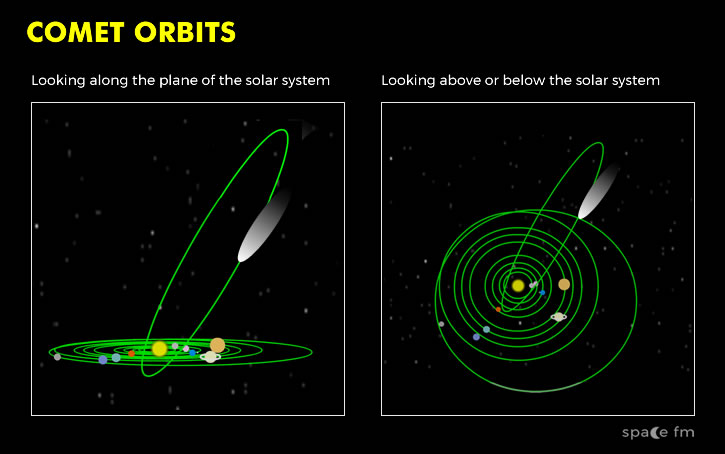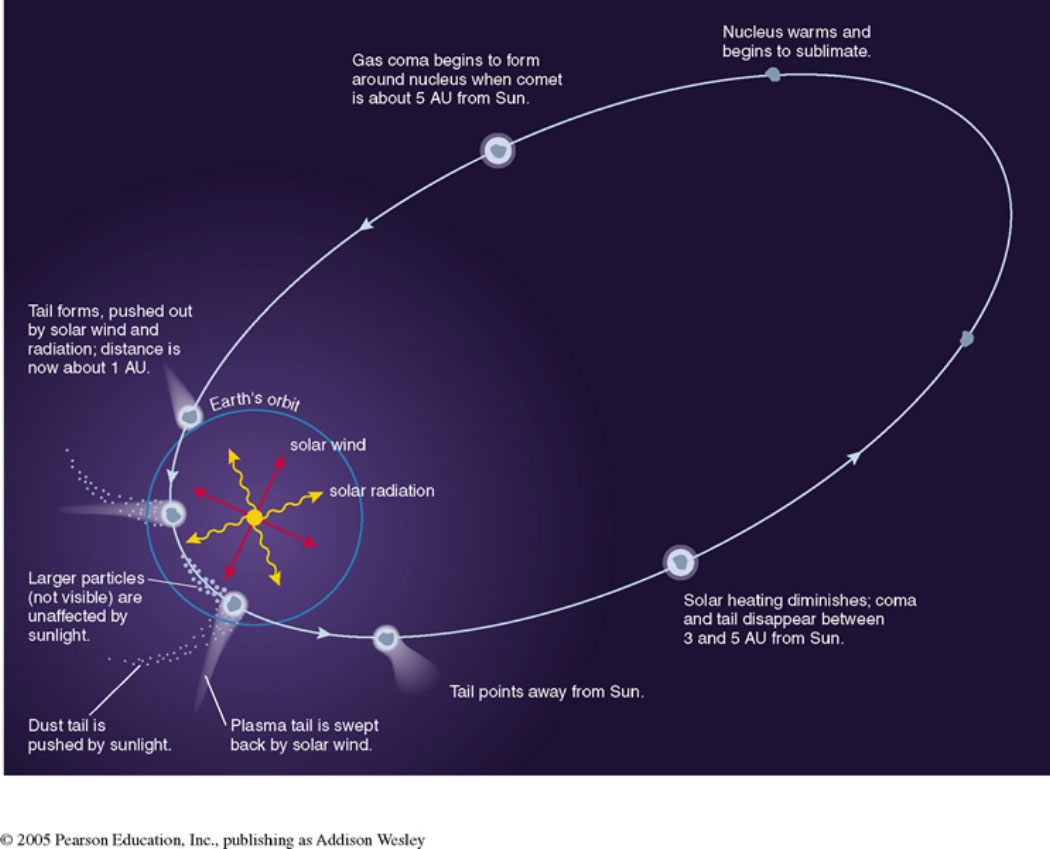Describe Comets and Their Orbits in the Solar System
As theorized by astronomer Gerard Kuiper in 1951 a disc-like belt of icy bodies exists beyond Neptune where a population of. Most stay far from the Sun.

Comet Orbits Solar System Space Fm
Their Nature Orbits and Impacts The Cosmic Perspective by Numerade Limited Time Offer Unlock a free month of Numerade by answering 20 questions on our new app StudyParty.

. Comets are cosmic snowballs of frozen gases rock and dust that orbit the Sun. The oscillations in the picture happened over 18 seconds. Planets orbit a line between Earth and the Sun called the ecliptic.
Most planets in the solar system have moons in orbit around them. Outline the story of the discovery of asteroids and describe their typical orbits. What is the period seconds per oscillation 2.
They are small compared to the planets. Why was it difficult for people to accept a heliocentric concept of the solar system. Comets are believed to have two sources.
Debris of the Solar System 451. Asteroids and comets and the meteors that sometimes come from them are leftovers from the formation of our solar system 46 billion years ago. Typically the eccentricity of their orbits is 08 or higher.
Describe asteroids and their orbits in. What phase of the moon would someone on Earth see when the moon is at Positions A through F. Aristotle was famous and his ideas were supported by religious teachings.
Video answers for all textbook questions of chapter 12 Asteroids Comets and Dwarf Planets. Planets also orbit the Sun in a prograde motion. Comets have an extremely eccentric orbit around the Sun.
Many craters seen in the Solar System are thought to be caused by such collisions. Comets are the space objects that are mostly made of ice and rock. In particular he noted that the orbits of the bright comets that.
The solar system consists of the Sun surrounded by planets comets and asteroids in orbit. Newtons colleague Edmund Halley see the feature box developed these ideas and in 1705 he published calculations of 24 comet orbits. Comets are small Solar System bodies typically only a few kilometres across composed largely of volatile ices.
Comparing their orbits to planets. They can travel hundreds of thousands of years through the solar system before returning to the Sun at perihelion. Its movement is due to the gravitational interaction with the sun and various celestial bodies in the solar system.
This place is made up of matter that due to the distance from the sun could never be integrated into the planetary formation. So comet aficionados pin their hopes to the unanticipated arrival. How did Keplers discoveries contribute to astronomy.
The dust and gases form a tail that stretches away from the Sun for millions of miles. Since comets are much smaller especially in comparison to the Gas Giants they are destroyed leaving behind an impact crater. The remaining population consists of long-period comets those that take at least 200 years to return to the inner solar system.
While the planets and moons have changed over the millennia many of these small chunks of ice rock and metal have not. These objects obit the sun and have other objects in the area of their orbits. Comets have what is called INCLINED orbits meaning they orbit at a higher or lower angle to the ecliptic.
When a comets orbit brings it close to the Sun it heats up and spews dust and gases into a giant glowing head larger than most planets. What do comets and asteroids have in common. When frozen they are the size of a small town.
Other comets have periods of several millions of years with orbits that take them far. According to Keplers second law therefore they spend most of their time far from the Sun moving very slowly. Comets are masses that are generated in a region called the Oort Cloud.
Danish astronomer Jan Oort proposed that comets reside in a huge cloud at the. Long-period comets those which take more than 200 years to complete an orbit around the Sun originate from the Oort Cloud. Short-period comets those which take less than 200 years to complete an orbit around the Sun originate from the Kuiper Belt.
They orbit around the sun in circular and elliptical orbits and are found across the whole solar system. They are at the center of the solar system. Short period comets 200 years like Halleys comet Short period comets may have originated in the Kuiper belt Kuiper belt comet gets kicked into an eccentric orbit bringing it into the solar system These long period comets probably originate in the Oort cloud Formation of the Solar System Any theory to describe the formation of our Solar System must adhere to these facts.
Other comets have periods of several millions of years with orbits that take them far. DEBRIS OF THE SOLAR SYSTEM Chapter 13 Comets and Asteroids. Comets generally have orbits of larger size and greater eccentricity than those of the asteroids.
Describe asteroids and their orbits in the solar system. Essentially this means they can be observed in any point in the sky. Comets like all orbiting bodies obey Keplers Laws which state that the closer they get to.
Some comets called periodic comets return near the Sun every few years and travel no further from the Sun than the orbit of Jupiter. 131 ASTEROIDS Learning Objectives By the end of this section you will be able to. Breakup of Comet S4 Linear.
They are a lot like a fossil record of planetary evolution. Some comets due to their orbits may cross the path of a planet or one of its moons and collide. Most comets travel in highly elliptical orbits around the Sun with orbital periods time between returns ranging from just over three years to millions of years.
The study of comets as members of the solar system dates from the time of Isaac Newton who first suggested that they orbited the Sun on extremely elongated ellipses. Describe dwarf planets and their orbits in the solar system. Comets orbit the Sun just like planets and asteroids do except a comet usually has a very elongated orbit.
They have highly eccentric orbits generally a perihelion within the orbits of the inner planets and an aphelion far beyond Pluto. Describe asteroids and their orbits in the solar system. They are around a few kilometers large and mostly have irregular shapes.
Describe comets and their orbits in the solar system.


Comments
Post a Comment